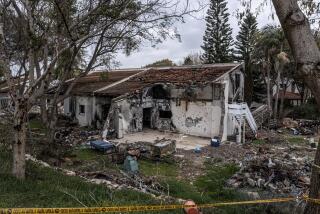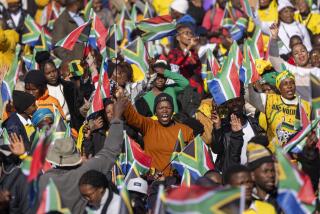A Final Report on Horrors of Apartheid
PRETORIA, South Africa — The final volume of the report of South Africa’s Truth and Reconciliation Commission is 976 pages long and heavy to hold.
Heavy, too, are its contents: the names of thousands of South Africans, followed by brief, chilling descriptions of how they were killed, tortured or left maimed or scarred in the three turbulent decades leading up to the country’s first democratic election, in 1994.
On Friday, the commission’s chairman, retired Anglican Archbishop Desmond M. Tutu, officially ended the panel’s work when he handed the last two volumes of its findings to South African President Thabo Mbeki.
Beginning with its first public hearings, in 1996, the commission took statements from more than 20,000 victims of apartheid -- South Africa’s system of strict racial segregation, which was instituted in 1950 and lasted for more than 40 years. It also received applications for amnesty from 7,115 perpetrators of wrongdoing as it probed serious human rights violations committed by supporters of apartheid and those fighting to topple it.
Tutu said Friday that he thought the commission had made real progress in its efforts “to heal a wounded and traumatized people.” But he said he was disappointed in two of the panel’s key missions: amnesty and reparations.
He expressed frustration that more white South Africans had not availed themselves of the chance for amnesty that the panel offered to those who fully confessed to, and accepted responsibility for, politically motivated wrongdoing.
He also said the government had been remiss in its duty to victims, who he said should promptly be paid reparations for their suffering. The stalling on reparations has upset many victims, who have watched hundreds of perpetrators of crimes receive amnesty while they got nothing.
“They have waited long, too long, for their reparations,” Tutu said in the afternoon ceremony held in the Union Buildings, the government offices where apartheid officials once held sway and where Nelson Mandela -- the country’s first post-apartheid president -- was inaugurated. Tutu called reparations “a matter of urgency and national honor” and said of the victims, “We should help them experience closure with dignity.”
In October 1998, when the commission delivered the first five volumes of its report to then-President Mandela, it recommended that, as a part of the healing process, the government pay 3 billion rand (about $375 million at the current rate of exchange) to more than 21,000 identified victims -- those who lived to tell their stories and the families of those who did not. But the government, which delivered small emergency payments to about 16,000 victims, said it would wait on the larger reparations issue until receiving the commission’s final report.
“We will study the report we have just received with the close attention it deserves and respond to its recommendations as quickly as possible. This includes the matter of reparations,” Mbeki said Friday while praising the commission. He said it had “ensured that we avoid a disastrous racial conflict that would have cost the lives of many people and denied us the possibility to reconstruct South Africa as a peaceful and nonracial country.”
The final report now goes to the country’s Parliament, which will debate its findings.
In its recommendations, the commission urged South African businesses that benefited from apartheid to contribute money for reparations, and suggested a one-time wealth tax to make them do so.
The commission also suggested that individual white South Africans -- all of whom benefited from apartheid by virtue of their race -- should find their own ways to redress the inequities that continue to threaten the country’s dreams. Tutu suggested, for instance, that people who could afford to should adopt poor families and help support them with small monthly payments.
“It would make a huge difference and help to narrow the gap between the rich and the poor, the haves and the have-nots, which we identified in our report as what is most likely to subvert any efforts at reconciliation,” he said.
Tutu said it amazes him every day that South Africa’s transformation to democratic rule has been so peaceful, even though many black South Africans still leave shacks without running water or electricity to go to work for rich white people in big homes.
“My white compatriots ought not to take that for granted,” he said.
The delivery of the final volumes of the report was delayed for almost a year when Zulu Chief Mangosuthu Buthelezi mounted a legal challenge to remove allegations of human rights violations by his Inkatha Freedom Party. A settlement in January allowed the report to remain largely unchanged, but Buthelezi was allowed to add a statement denying the charges.
Over the years, others -- including the ruling African National Congress and former President Frederik W. de Klerk -- also mounted legal challenges. In a settlement with De Klerk, the commission agreed to black out a page of Volume 6, although the ex-president did admit to knowing that the apartheid government had authorized the 1988 bombing of a building in Johannesburg and that the bombing, although it killed no one, had been reckless.
The hand-over of the final Truth Commission report occurred on Human Rights Day, a holiday in South Africa. The date -- March 21 -- is the anniversary of the 1960 Sharpeville massacre, when police fired into a crowd of protesters, killing 69.
Tutu and his fellow commissioners began the day at a service at St. Alban’s Cathedral in Pretoria, the country’s administrative capital.
In the nave, the families of several dozen people killed by apartheid-era violence slowly proceeded down the central aisle, holding mementos of their loved ones. Then they tenderly placed photographs, worn T-shirts, plates and pairs of old shoes in front of the altar, as choirs filled the air with hymns.
More to Read
Sign up for Essential California
The most important California stories and recommendations in your inbox every morning.
You may occasionally receive promotional content from the Los Angeles Times.











